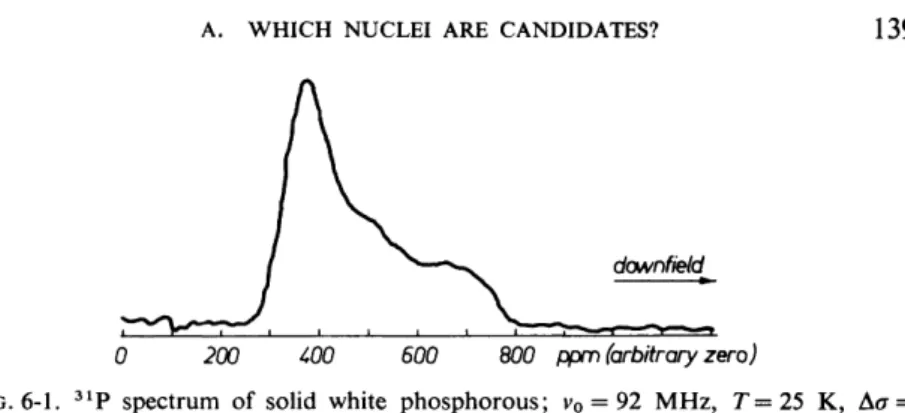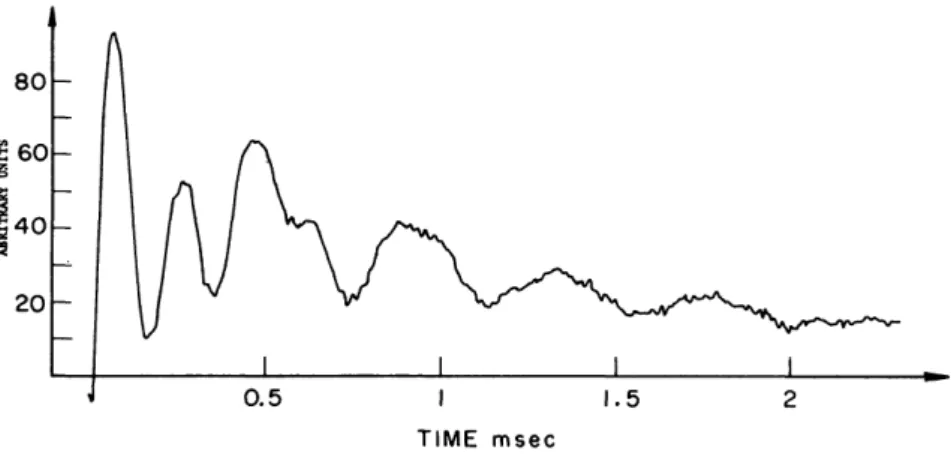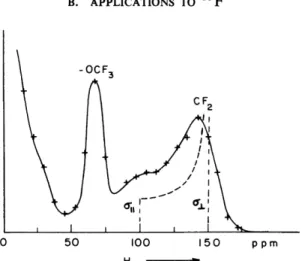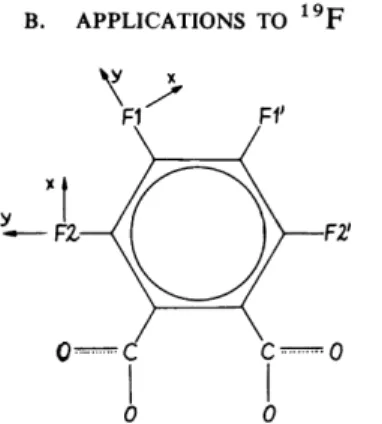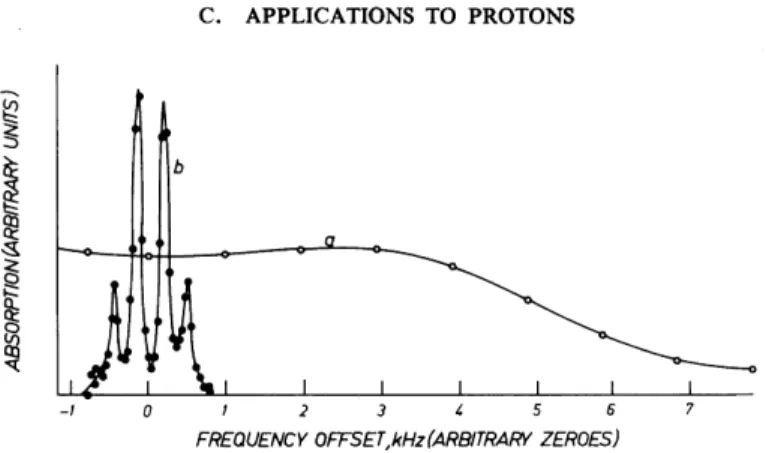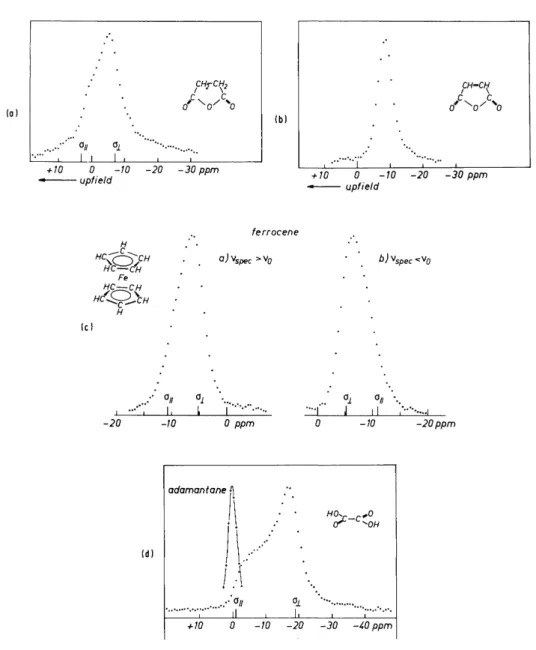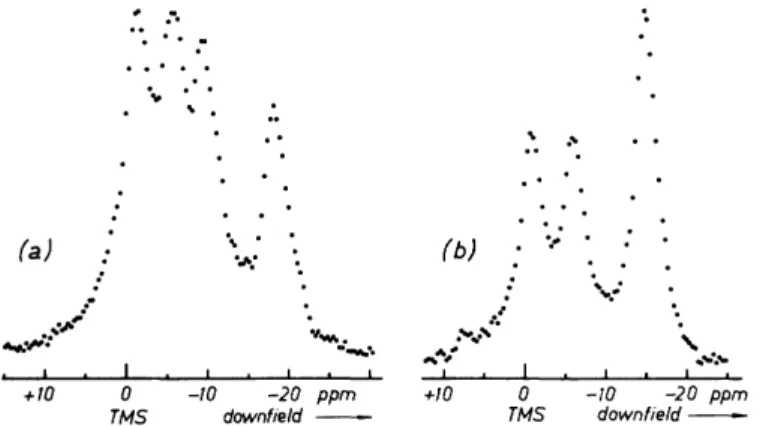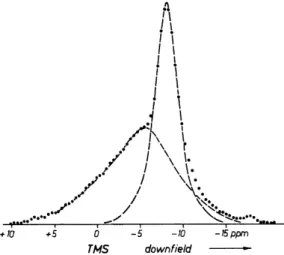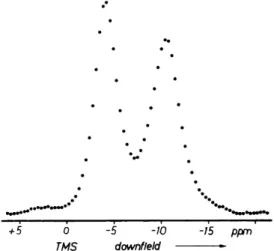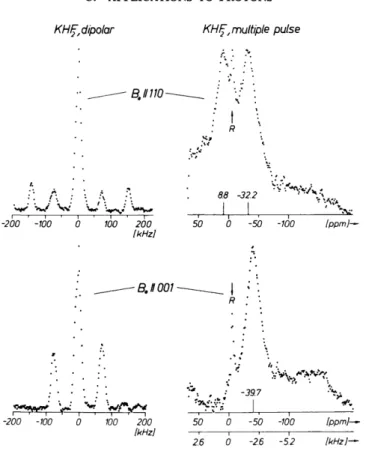VI. Applications of Multiple-Pulse Techniques
A. Which Nuclei Are Candidates?
The stated goal of high-resolution NMR in solids by multiple-pulse tech- niques is the measurement of shielding tensors in the presence of strong homonuclear dipolar couplings. For what nuclei—to be modest let us add with / = \—do we typically encounter in solids the situation invoked by the preceding sentence? We start by considering
1. PROTONS
In typical organic compounds and inorganic compounds containing crystal water the proton dipolar linewidth is of the order of 20 to 60 kHz. The splitting of the proton resonance from, e.g., isolated CH2 groups and H20 molecules ranges up to 64 and 82.5 kHz, respectively. Proton chemical shifts, including shift anisotropies, cover a range of about 30 ppm. Recall that isotropic chemical shifts of protons in diamagnetic compounds cover a range of roughly 12 ppm only, aside from a few pathological exceptions. 30 ppm corresponds to line shifts of 1.8, 2.7, and 10.8 kHz, respectively, for 60, 90, and 360 MHz spectrometers, which are or are becoming standard.
The conclusion is that proton shifts in solids are usually masked by dipolar line broadening even for 90- and 360-MHz spectrometers. Multiple-pulse techniques are definitely required to measure proton shielding anisotropies.
This is particularly so as the results of the liquid-crystal technique—practically the only alternative source of information for proton shielding anisotropies—
are such that the authors of a very recent review30 feel that they must qualify them as "generally unreliable."
The numbers quoted above make clear, on the other hand, that meaningful 137
multiple-pulse work on protons in solids can be done with a spectral resolution much worse than is standard in high-resolution NMR in liquids. Linewidths in excess of 200 Hz are often tolerable, provided the spectra are simple enough in the sense that they contain a few lines only.
It should also be mentioned that there are compounds where the protons or pairs of protons are so diluted that a straightforward measurement of proton shielding tensors is possible. An example is trichloroacetic acid.108
The next candidate for multiple-pulse work is 2. 1 9F
Dipolar linewidths in completely fluorinated compounds tend to be some- what smaller than those of the corresponding protonated compounds; the main reason is larger 1 9F-1 9F internuclear distances. The largest dipolar splitting of the pair of lines from, e.g., a CF2 group is 33 kHz.
A major difference from protons exists in the range of chemical shifts and shift anisotropies. Typical values of 1 9F shift anisotropies are 150 ppm, but numbers in excess of 1000 ppm have been reported (see Tables X-XIII of Appleman and Dailey30). 150 ppm corresponds to lineshifts of 9, 13.5, and 54 kHz for 60-, 90-, and 360-MHz spectrometers, respectively. Hence, the range of 1 9F chemical shifts (shift anisotropies) is comparable to or even larger than 1 9F-1 9F dipolar line broadening—provided one exploits the strongest magnetic fields now available for NMR purposes. Modest suppres- sion of 1 9F-1 9F dipolar couplings by some multiple-pulse sequence will already reveal 1 9F shift anisotropies in simple cases. Quite naturally, more complex compounds with more complex spectra become amenable to investi- gation if higher resolution is available.
Skipping 3He (exotic) and 203T1, 205T1 (exotic, strongly toxic), which would come next according to their magnetic moments, we proceed to consider briefly
3. 31P
On the one hand 31P chemical shift anisotropies are usually large—several hundreds of ppm (see Table109 XIV of Appleman and Dailey31). On the other hand the density of 31P in solids is usually so low that in reasonably strong magnetic fields the spread of the spectra due to chemical shifts by far exceeds the 3 1p_3 1p dipolar line broadening. An example is provided by Fig.
6-1, which shows the 3 1P spectrum of solid white phosphorous recorded at 25 K by standard Fourier transform techniques at 92 MHz. This frequency
1 0 8 D. C. Haddix and P. C. Lauterbur, Nat. Bur. Stand. {U.S.), Spec. Publ. 301, 403 (1969).
1 0 9 The value of Δσ quoted there for P4 is in error; see below and Spiess et al.31
A. WHICH NUCLEI ARE CANDIDATES? 139
/ x— ^ . downfield
i ^ ^ »- i V * i . i i 1 i i 1 i — 1"" ""'l ' "3L
0 200 400 600 800 ppm (arbitrary zero)
FIG. 6-1. 3 1P spectrum of solid white phosphorous; v0 = 92 MHz, T=25 K, Δσ = - 4 0 5 ± 15 ppm (from Speiss et al.31).
corresponds to a magnetic field of "only" 5.3 Tesla (53 kG)—8.5 Tesla is becoming standard!
White phosphorous consists of P4 tetrahedra; the 31P nuclei sit on threefold (molecular) symmetry axes. The 31P shielding tensors are, as a result, axially symmetric. This is what Fig. 6-1 displays. The anisotropy is σ^ — σ± = -405 ppm. This corresponds at 92 MHz to more than 37 kHz. According to a com- puter fit of this spectrum, but also according to a theoretical estimate based upon the second moment, the dipolar width of the component lines is about 2.5 kHz.
31P spectra of single crystals of P4S3 have been recorded at 98 MHz by Gibby et al.110 Here, too, the chemical shifts by far exceed the dipolar linewidths.
These examples are typical, and only in complex cases where very high resolution is really required will there be a need of bothering about multiple- pulse techniques if one is interested in 31P shielding anisotropies. Usually it is much simpler and eventually also much cheaper to buy a high-field super- conducting solenoid and to do just standard FT spectroscopy.
What we have said about 31P holds true, a fortiori, of all further nuclei with spin \. Thus our final conclusion is:
For the measurement of chemical shift tensors, multiple-pulse line- narrowing techniques are really needed only for protons, and to a lesser extent already, for 1 9F.
This is not to say, however, that there are no applications at all of multiple- pulse techniques to other nuclei.
Mehring and Raber1 * 1 have applied, for example, such techniques to powder samples of metallic 27A1 (/ = f) and 9Be (/ = f) and obtained highly precise values for the isotropic Knight shifts.
1 1 0 M. G. Gibby, A. Pines, W.-K. Rhim, and J. S. Waugh, / . Chem. Phys. 56, 991 (1972).
111 M. Mehring and H. Raber, Proc. 1st Spec. Colloq. AMPERE, 1973 p. 216 (1973).
B. Applications to 9F
Applications of multiple-pulse line-narrowing techniques to 1 9F have been reviewed very recently by Appleman and Dailey in an article about nuclear magnetic shielding and bulk susceptibility anisotropies.30 This article is recommended for information concerning
(i) alternative experimental approaches to chemical shift anisotropies such as liquid-crystal solvent, molecular-beam, and double-resonance tech- niques, and relaxation and second moment methods, etc;
(ii) a comprehensive list of, on the one hand ab initio calculated, and on the other hand, experimentally measured 1 9F shift tensors and shift an- isotropies including data published until 1972;
(iii) the current status of ab initio calculations of nuclear magnetic shielding tensors.
We shall not undertake to review this field again; rather we shall restrict ourselves to some representative applications of multiple-pulse techniques.
1. A "HISTORICAL" EXAMPLE: THE FIRST MEASUREMENT OF CHEMICAL SHIFTS IN A SOLID BY MULTIPLE-PULSE TECHNIQUES112
In the MIT NMR group we have been able since the end of 1967 to narrow down to 100-200 Hz the 1 9F resonance line in CaF2 by using the WAHUHA sequence, but it was not before the fall of the following year that we could observe for the first time a beat structure in the multiple-pulse response of a solid sample (see Fig. 6-2) and, correspondingly, a spectrum with resolved
TIME msec
FIG. 6-2. NMR signal of TFE/PFMVE during a WAHUHA experiment. The train contained about 100 four-pulse cycles (from Ellett et al.112).
1 1 2 D. Ellett, U. Haeberlen, and J. S. Waugh, Polym. Lett. 7, 71 (1969).
B. APPLICATIONS TO 1 9F 141
0 50 100 150 ppm H *>
FIG. 6-3. Fourier transform of the trace shown in Fig. 6-2 (from Ellett et al.112).
peaks (Fig. 6-3). The sample happened to be a tetrafluoroethylene/perfluoro- methylvinyl ether (TFE/PFMVE) copolymer. We were able to determine the (isotropic) 1 9F chemical shifts in the — OCF3 and CF2 positions and made an attempt to derive a value for the 1 9F shift anisotropy in the CF2 position. The result (« + 50 ppm), however, is not very meaningful because of ill-defined molecular motions. A breakthrough with respect to shift anisotropies was achieved in 1970 by a series of
2. POWDER STUDIES OF PERFLUORINATED COMPOUNDS
These studies were carried out by the MIT NMR group.14 Textbook examples of powder patterns characteristic of both axially symmetric (C6F6; Fig. 2 of Mehring et al.14) and nonaxially symmetric (Fluoranil, C6F402; Fig. 1 of Mehring et al.14) shielding tensors were presented. The authors were able to determine 1 9F principal shielding components in a number of compounds with unprecedented unambiguity. It is worthwhile to stress this point since the bulk of attempts to measure shielding anisotropies (a less ambitious goal than measuring principal shielding components!) mainly by the liquid-crystal solvent technique is beset with a frustrating amount of ambiguities. In fact, the discussion of 1 9F shielding anisotropies by Appleman and Dailey30 is primarily concerned with such questions.
The most interesting features of the results of 1 9F multiple-pulse powder studies are
(a) 1 9F shielding tensors are not generally axially symmetric as has often been assumed previously. The principal components of the traceless con- stituent σ( 2 ) of σ in, e.g., Teflon [CF2]M are, respectively, —80, +21, and + 59 ppm.
TABLE 6-1
COMPARISON OF 1 9F PRINCIPAL SHIELDING COMPONENTS IN CF3 GROUPS AND AROMATIC SYSTEMS0
Ref.
( C F3C O )2O ( 7 = 4 0 K ) C F3C O O A gb( ^ = 8 3 K ) Hexafluorobenzene Perfluoronaphthalene Perfluorobenzophenone Perfluorobiphenyl
Potassium tetrafluorophthalate
° The table gives the principal components of σ( 2 ) which is the traceless symmetric con- stituent of σ.
b A single-crystal crystal study of this compound has been carried out by Griffin et al.,19 see also Section B,3.
TABLE 6-2
PRINCIPAL 1 9F SHIELDING COMPONENTS FOR FLUORINATED BENZENES0' F
σχχ ayy σζζ
1,3,5 C6H3F3
1,3 C6H4F2 C6H5F 1,4C6H4F2
1,2 C6H4F2
1,2,4,5 C6H2F4
C6F6
1
I
II I 1
- 1 0 0 - 5 0 0 + 5 0 +100 + 1 5 0 p p m
L
0 After Mehring et αΙ.,ΊΊ ρ. 35.
b The assignment of the principal direction is according to the results of a single-crystal study of perfluorophthalate.113
- 7 5 - 1 + 7 6 - 6 7 - 3 + 7 0 - 5 1 . 7 - 5 1 . 7 +103.4 - 5 0 - 5 0 +100 - 6 6 - 3 1 + 9 7 - 4 5 - 4 5 + 9 0 - 6 4 - 4 8 +89
6 * L ·
1 1 3 R. G. Griffin, H.-N. Yeung, M. D. LaPrade, and J. S. Waugh, / . Chem. Phys. 59, 777
(1973).
B. APPLICATIONS TO 1 9F 143 (b) 1 9F principal shielding components in related compounds tend to be similar. As we shall see presently this is not a matter of course. Examples for CF3 groups and aromatic systems are given in Table 6-1.19,14'113
(c) There are striking differences in the x 9F principal shielding components in compounds that are supposedly closely related (see Table 6-2).
The conclusions one is pushed to draw from Table 6-2 are as follows: Each ortho-fiuor'me shifts the zz component by about +50 ppm. Para and meta substitution does not affect σζζ appreciably. ayy (bond direction) is rather insensitive to any kind of substitution and σχχ changes gradually. Clearly, there is also a change in the mean or isotropic value of the shift, which has been known for some time as the so-called ortho effect.114'115 So far there is no theory that satisfactorily accounts for the ortho effect.
(d) The quality of the experimental results is so good that asking the following question is not only meaningful but urgent: What do the measured principal shielding components tell us about the compounds, and possibly about their electronic structures? After all, one of the motivations for measuring shielding tensors is getting information about electronic states!
Mehring et al. have tried to analyze some of their data in the framework of valence theory,114 which relates the so-called paramagnetic parts (see Section C,3) of the principal shielding components to the "populations" of the fluorine p orbitals. These populations, in turn, are related to the amounts of double bond (p) and ionic (/) characters, and to the degree of sp hybridization (s) of the C—F bond. The numbers quoted by Mehring et al.14 for (I+s — Ls) imply that the C—F bonds in hexafluorobenzene, perfluoronaphthalene, fluoranil, teflon, etc., are either almost purely ionic or almost purely double bonds. Both implications are evidently unacceptable. The main conclusion is thus that valence theory in the formulation of Karplus and Das1 1 4 is inade- quate for describing 1 9F principal shielding components. Let us try to under- stand why this is so. First, there is the difficulty of separating the experimental quantities σχχ, ayy, σζζ into their "paramagnetic" and "diamagnetic" parts.
The way Mehring et al. solve this difficulty is reminiscent of the origin of the zero of the Fahrenheit temperature scale.116 They assume that the most shielded value observed until 1971 (σζζ of C6F6) is due solely to diamagnetic shielding (a(d)) and that this value can be taken as a fair approximation of a(d) also for the other compounds of the series considered. Second, and much more seriously, the Karplus and Das theory has a built-in inadequacy since it resorts to the so-called closure approximation. The closure approximation
114 M. Karplus and T. P. Das, J. Chem. Phys. 34, 1683 (1961).
115 J. Nehring and A. Saupe, /. Chem. Phys. 52, 1307 (1970).
116 Fahrenheit defined as zero the lowest temperature he could produce by mixing water, ice, and ammonium chloride.
means that one single "average" excitation energy is assigned to all excited electronic states of the molecule.
Now, from the analysis of some 13C shielding tensors117 we do know that σ^?, σ$, σ£\ and in particular the differences between them are intimately related to one or at most very few of the excited electronic states and their excitation energies. This means that any theory based on the closure approxi- mation is bound to fail in these cases. The same situation can safely be expected to prevail for 1 9F and other nuclei in many compounds.
(e) Powder studies in general can reveal only principal shielding com- ponents, but not principal directions. When these directions are fixed by symmetry, powder studies still cannot reveal which principal component belongs to which principal direction except when axial symmetry of σ is enforced by crystal symmetry (three- or higher-fold axis through site of nucleus of interest).
A special case is encountered in C6F6, where such a symmetry can be switched on and off by changing the temperature of the sample.
The principal 1 9F shielding directions in C6F6 are fixed by molecular symmetry: one is perpendicular to the molecular plane and thus parallel to the molecular C6 axis, another is parallel to the C—F bond, which is a C2
axis, and the third is necessarily perpendicular to the other two. At 200 K Mehring et al1Ar obtained from C6F6 a powder pattern characteristic of an axially symmetric shielding tensor. This is no surprise since the C6F6 molecules are known to reorient rapidly about their sixfold axes at this temperature. The parallel component σ^ (shoulder of powder pattern) is a principal shielding component and necessarily corresponds to the C6 axis. σ± (peak of the powder pattern) is, on the other hand, the average of the two in-plane components.
The experiment was repeated at 40 K, where the reorientations have slowed down enough so that the molecules may be considered—with regard to shielding—as being stationary. Surprisingly, the 40 K multiple-pulse spectrum turned out to be identical to the 200 K spectrum. This implies that the in-plane shielding components are equal (to within the accuracy of the experiment) and that the 1 9F shielding tensor in C6F6 is axially symmetric. However, the symmetry axis is not the bond direction, but rather the sixfold symmetry axis of the molecule. Note that the 1 9F site symmetry in C6F6 does not include a sixfold symmetry axis so that this result is not a consequence of symmetry.
C6F6 is an exceptional case, however.
In general, principal shielding directions can only be found by
3. SINGLE-CRYSTAL STUDIES
1 9F shielding tensors have been studied by multiple-pulse techniques in single crystals of the following compounds:
1 1 7 J. Kempf, H. W. Spiess, U. Haeberlen, and H. Zimmermann, Chem. Phys. 4,269 (1974).
B. APPLICATIONS TO 1 9F 145 CaF2: not interesting because the 1 9F site symmetry is cubic; MgF2, ZnF2: Stacey et al.11B, Vaughan et al.119; silver trifluoro-acetate: Griffin et al.19; potassium tetrafluorophthalate: Griffin et al.113
a. MgF2,ZnF2lls>119
MgF2 and ZnF2 are isomorphic. The site symmetry of 9F is v^2v; as a consequence all three principal directions are determined by symmetry. What remains for the experimenter is to measure σχχ9 ayy, σζζ and to assign them to
"their" principal directions.
The first part of the task can be done in a straightforward way by taking rotation patterns about suitable axes (see Chapter III, Section B). This is what Stacey et al.118 and Vaughan et al.119 did. Their results for σχχ, ayy9 and σζζ are 13, 28, and 43 ppm for MgF2, and 15, 38, and 59 ppm for ZnF2 relative to liquid hexafluorobenzene.
The second part involves a not unusual difficulty: While the data allow an unambiguous assignment of σχχ to the C2 axis, ayy and σζζ cannot be assigned unambiguously. The reason is that in MgF2 (and in ZnF2) there are two magnetically inequivalent but crystallographically equivalent fluorine sites, and it so happens that the y direction of one site coincides with the z direction of the other. As there is no purely experimental way of telling which of the (in general) two lines of the spectra arises from which site there is no purely experimental way of assigning ayy and σζζ. Vaughan et al}19 do propose an assignment, but it is based on theoretical (which means on completely different) grounds than the assignment of σχχ.
b. Silver Trifluoro-Acetate19
The trifluoromethyl group in silver trifluoro-acetate (CF3COOAg) has been studied by the MIT NMR group both at room temperature and at 40 K. At room temperature the CF3 group is rapidly reorienting about the C—C bond, so partially averaged shielding tensors can be measured only. At 40 K the reorientations are effectively frozen out. What makes this study of the CF3
group particularly exciting is the following:
In CF3COOAg kept at 40 K the F atoms of the CF3 group are magnetically inequivalent. In fact, there are two magnetically inequivalent but crystallo- graphically equivalent CF3 groups. This is, however, not so important and therefore let us focus attention on one CF3 group. Its F atoms are not only magnetically but also crystallographically inequivalent. Moreover, there is no symmetry argument whatsoever that would allow a prediction of any one of the principal shielding directions of any one of the F atoms. In short, the shielding tensors of the F atoms in the CF3 group of CF3COOAg are com- pletely independent and nothing is predetermined by symmetry.
118 L. M. Stacey, R. W. Vaughan, and D. D. Elleman, Phys. Rev. Lett. 26, 1153 (1971).
119 R. W. Vaughan, D. D. Elleman, W.-K. Rhim, and L. M. Stacey,/. Chem. Phys. 57,5383 (1972).
Of course, our chemical and physical intuition tells us that these shielding tensors ought to be very similar. After all, in an isolated —CF3 group the F atoms are crystallographically equivalent and we suspect that incorporating CF3 groups in (CF3COOAg)2 dimers and into a rather loosely packed crystal does not alter the shielding tensors dramatically.
Now let us look at the experimental results of Griffin et al.19 At 40 K the following principal shielding components (relative to CaF2) and anisotropies were measured for the fluorine atoms labeled Fl, F2, F3 in Griffin et al.19:
σχχ (ppm) ayy (ppm) σζζ (ppm) Δ σ = σζζ - \(σχχ + ayy) (ppm) Fl - 6 4 . 3 - 4 . 3 + 6 0 94.3 F2 - 7 5 . 0 +1.9 +73.1 109.7 F3 - 7 3 . 6 - 6 . 6 + 8 0 120.1
The most shielded directions lie approximately along the respective CF bonds, the tilt being 9.7, 11.5, and 7.8° for atoms Fl, F2, and F3, respectively. The least shielded directions are approximately perpendicular to the respective C—C—F planes.
We see that there are differences of up to 20 ppm in the principal components and differences in the anisotropy of more than 25 ppm out of a total range of 120 ppm and we really think that such differences should be called dramatic.
Why are these differences so big? Honestly, we do not know, but Griffin et al. at least indicate what they are probably due to. The most conspicuous differences are between Fl on the one, and F2, F3 on the other hand. Griffin et al. suggest that the shielding differences are the result of an eclipsed position of Fl relative to one of the oxygen atoms of the carboxyl group. Explanations on a "higher" level still belong to the land of dreams at present!
Another incentive for investigating CF3 groups in rigid solids is the follow- ing: Deeply engraved in the mind of almost every chemist is the notion that /coupling within CF3 groups is unobservable. However, the condition for the unobservability of J coupling between F atoms—magnetic equivalence of F atoms—is not fulfilled in a rigid solid and therefore / coupling becomes, in principle, observable. Nevertheless, in this particular experiment it could not be observed, probably because the size of the coupling constants was too small for the available spectral resolution.
c. Potassium Tetrafluorophthalate113
In isolated molecules of monofluoro-, 1,3,5-trifluoro-, and hexafluoro- benzene all principal shielding directions are fixed by molecular symmetry.
Only one is fixed in, e.g., 1,2-difluorobenzene. It is perpendicular to the molecular plane. What about the other two? The results on the trifluoromethyl group quoted above prompt us to be cautious in merely making assumptions.
B. APPLICATIONS TO 1 9F 147
0 0
FIG. 6-4. The tetrafluorophthalate anion. Principal shielding components in ppm relative to liquid C6F6 are
σχχ{\) = - 5 8 , ayy{\) = - 4 7 , σΪΧ(1) = +94.5, σχχ(2) = +73, σ„(2) = -55, σζζ(2) = +63.
After Griffin et al.113
Single crystals of fluorinated benzenes are difficult to investigate because of low melting points and complex crystal structures. Potassium tetrafluoro- phthalate, on the other hand, is convenient and has a bearing on the question just asked: melting point above room temperature and all molecules magneti- cally equivalent. Griffin et al. studied this compound and found for both
types of fluorine (Fl and F2 in Fig. 6-4) that indeed the perpendicular to the molecular plane and the respective C—F bonds are very close to principal
1 9F shielding directions. This fixes the in-plane perpendiculars to the bonds as third principal directions. For Fl as well as for F2 the perpendicular to the plane is the most shielded, the C—F bond direction the intermediate, and the in-plane perpendicular to the bond the least shielded direction. These results justify the assignments in Table 6-2 for the di- and tetrafluorinated benzenes.
We close our discussion of 1 9F multiple-pulse single-crystal studies with a comment.
d. Comment on Powder Studies
With few exceptions powder studies can yield accurate values of principal shielding components only when all nuclei that contribute to the spectra occupy crystallographically equivalent sites. We can analyze powder patterns only in these cases in terms of one single set of principal components.
Now, there are very few "systems" in nature where 1 9F nuclei meet this condition. Thus very few substances appear to be amenable to powder studies. Facing this situation one may be inclined to loosen somewhat the rigor and assume that all nuclei occupying equivalent positions in the isolated molecule or even all nuclei bonded similarly (as are the F atoms in potassium tetrafluorophthalate) have similar enough principal shielding components for
the powder pattern to be analyzable in terms of a single set of principal shielding components.
This assumption had been made tacitly in some of the powder studies quoted in Section B,2. One lesson the available single-crystal studies teaches us is—to express it cautiously—that we must be very cautious with such assumptions and that we must be prepared to be misled.
4. MOLECULAR MOTIONS STUDIED BY MULTIPLE-PULSE TECHNIQUES
The traditional way of studying molecular motions in solids by NMR is by spin-lattice relaxation of the Zeeman energy (7^), of the Zeeman energy in the rotating frame (Tlp), and of the dipolar energy (T1D), and by the second moment of resonance lines. These methods are not very specific to various kinds of motions. At each temperature and spectrometer frequency one gets just a one-number answer from the system.
Powder pattern lineshapes, on the other hand, can be considerably more informative: At each temperature one measures an entire function g(co). One condition for g(a>) to carry specific information about molecular motions is that it be governed by predominantly intramolecular or even single-bond effects such as chemical shift anisotropy in contradistinction to dipolar effects, which are typically almost equally inter- and intramolecular in origin and which rarely are specific to the orientations and motions of a molecule. What we have just stated is borne out by some recent studies of molecular motions where either "high" magnetic fields of about 6 T= 60 kG are exploited to produce, in absolute terms, large chemical shifts and shift anisotropies of 31P and 1 3C,3 7 or where use has been made of the feasibility to decouple 13C from protons in solids.120
An example where 1 9F line narrowing by multiple-pulse techniques was successfully used to produce the required spectral resolution for studying molecular motions is perfluorocyclohexane,121'122 C6F1 2.
Figure 6-5 shows the ordinary (a) and the multiple-pulse (b) spectrum of C6F1 2 at 200 K. The multiple-pulse spectrum is approximately an AB quartet reflecting the presence of distinguishable interacting axial and equatorial fluorines (<5 = 18.2 ppm, / = 284 Hz). At 200 K the multiple-pulse spectrum carries no information about chemical-shift anisotropy. This is due to rapid reorientations of the C6F1 2 molecules (which are globular in shape) at their lattice sites. Dipolar interactions are reduced by these reorientations, but they are not suppressed altogether. In particular, some of the intermolecular dipole-dipole interactions remain static and lead to the broad structureless spectrum (a) of Fig. 6-5.
Axial and equatorial fluorines are exchanged by chair-to-chair inversions of the C6F1 2 molecules. High inversion rates as they occur at T ^ 267 K
1 2 0 A Pines, M. G. Gibby, and J. S. Waugh, / . Chem. Phys. 59, 569 (1973).
1 2 1 D. Ellett, U. Haeberlen, and J. S. Waugh,/. Amer. Chem. Soc. 92, 411 (1970).
1 2 2 D. Ellett, R. G. Griffin, and J. S. Waugh, J. Amer. Chem. Soc. 96, 345 (1974).
C. APPLICATIONS TO PROTONS 149
I I
- 1 0 1 2 3 4 5 6
FREQUENCY OFFS ETykHz (ARBITRARY ZEROES)
FIG, 6-5. 19F NMR spectra of solid C6F12 at 200 K. (a) Normal spectrum, from Fourier transformation of FID, showing restricted molecular rotation in situ; (b) multiple-pulse spectrum under the same conditions, showing lack of ring inversion. From Ellett et al.121 Reprinted with permission from /. Amer. Chem. Soc. 92, 411 (1970). Copyright by the American Chemical Society.
lead to a collapse of the quartet into a single line.
A study of the transition with temperature of the four-line into a single-line spectrum by Ellett et al.122 allowed a measurement of the temperature dependence of the inversion rate and a determination of the associated activation enthalpy and entropy.
C. Applications to Protons
For about two decades, isotropic chemical shifts of protons have become a standard tool of organic chemists, and thousands and thousands of proton
"shifts" have been measured with fantastic precision. On the other hand, our knowledge of the anisotropy of proton shifts, or more generally, of proton shift tensors was very poor until very recently.
In their 1974 review of magnetic shielding anisotropies Appleman and Dailey30 described the situation in the following terms:
"(i) The most extensively used technique for determining proton an- isotropies, the liquid-crystal method, has been found to be generally unreliable due to large uncertainties and the small range of proton shifts.
(ii) Other techniques have also been less well suited for accurate measure- ments of proton anisotropies.
(iii) The ab initio theoretical methods have generally been considerably less successful for proton shielding than for the other nuclei listed above (i.e., for1 3C, 1 9F, 1 4'1 5N, 1 70 , 3 1P)."
By "other techniques" Appleman and Dailey evidently mean, in partic- ular, multiple-pulse techniques. As far as we can see, there has been no breakthrough in the liquid-crystal method since the completion of Appleman
and Dailey's manuscript. The success of multiple-pulse techniques in eluci- dating proton chemical shift tensors, however, has changed markedly and hopefully the following pages will convince the reader of this claim. Also, at least a qualitative rationalization of the experimental results is often easier for protons than for other nuclei such as 13C and 1 9F.
L A FIRST SURVEY OF PROTON SHIFT ANISOTROPIES: POWDER STUDIES
Isotropie chemical shifts of protons are characteristic of the chemical bonds in the immediate neighborhood of the respective protons. This is proven by the very fact that charts of proton shifts can be constructed. It may be expected that there is also a relation between bonds and the tensor properties of shifts.
We therefore looked for prototype compounds containing protons in "typical"
aliphatic-, aromatic-, olefinic-, carboxylic-,..., bonding situations, which, in addition, were well suited for powder multiple-pulse work.
The most important conditions for being "well suited" are
(i) All protons should possibly be crystallographically equivalent. At least, they should be chemically equivalent, which means equivalent in the isolated molecule (see above).
(ii) The compound should preferably be a (rigid) solid at room tempera- ture. This is not merely a matter of convenience as it may seem. For proton multiple-pulse work it is vital to have the spectrometer alignment at its optimum. The alignment, however, depends on the temperature of the probe.
Each change of temperature requires realignment. "Interesting" samples usually cannot be used for realignment because of long relaxation times. Test samples are therefore needed for realignment and the rapid exchange of test and "interesting" samples at, say, liquid nitrogen temperatures does cause complications.
From the point of view of comparing eventual experimental results with theoretical calculations it would be desirable to choose those very small, highly symmetric molecules preferred by "ab initio-ians." Unfortunately most of these compounds—CH4, C2H4, C2H6, COH2, etc.—are either liquids or gases at room temperature and thus do not qualify as "well suited."
We therefore choose succinic acid anhydride, maleic acid anhydride, ferrocene, and oxalic acid as prototype compounds containing aliphatic, olefinic, aromatic, and carboxylic protons, respectively. The protons in all these compounds are equivalent at least in the isolated molecules and thus meet condition (i). With the exception of ferrocene they are effectively rigid at room temperature. The C5H5 rings of ferrocene reorient rapidly around their C5
axes123 so only the shielding component parallel to this axis (σ||), and the average of the in-plane components are measurable.
Figure 6-6 (reproduced from Haeberlen and Kohlschütter123) shows
1 2 3 U. Haeberlen and U. Kohlschütter, Chem. Phys. 2, 76 (1973).
C. APPLICATIONS TO PROTONS 151
(o)
· · - , I i 1 1
CHrCH2
/
No ' S
+ 10 0 -10 -20 -30 ppm
* upfield
(b)
' ' CH·
c ■at C
+ 10 0 -10 -20 -30 ppm
·+ upfield
Fe
H (c)
ferrocene
aJvspec>v0 ^ vs p e c< v0
-20 -10 0 ppm ■ " ' ' - . I
-20 ppm
(d)
adamantane A
+ 10
1 i 11-·
/ :ί
0 -10 9L 1,
-20
HG._C,O or ^OH
1 1
-30 -40 ppm
FIG. 6-6. Multiple-pulse powder spectra recorded at v0 = 90 MHz. The reference is always adamantane. (a) Succinic acid anhydride, Δσ « + 10 ppm; (b) maleic acid anhydride, no anisotropy detectable; (c) ferrocene, both up- and downfield spectra are shown;
ΔσΑ-5.5 ppm; (d) anhydrous oxalic acid, Δσ = + 17.8 ppm. From Haeberlen and Kohlschütter.123
multiple-plus powder patterns of these compounds. None of them is reminis- cent of a nonaxially symmetric shift tensor, although our results from single- crystal studies of maleic acid and monopotassium maleate strongly suggest that under the powder spectrum of maleic acid anhydride there is hidden a shielding tensor with η « 1. However, the range of shifts is too small to produce prominent shoulders in the spectrum.
The spectra of ferrocene are slightly asymmetric, which is indicative of a slight shielding anisotropy. The positions of σ^ and σ± in Fig. 6-6 are the result of a least-squares computer fit. (A later single-crystal study of ferrocene yielded Δσ = — 6.5 + 0.1 ppm; see Spiess et al.102). The asymmetry of the succinic acid anhydride spectrum is very marked. According to the computer fit the anisotropy is about +10 ppm. The anhydrous oxalic acid spectrum is a beautiful example of a powder spectrum resulting from an axially symmetric shielding tensor. The values for σ^ and σ± are given in the figure and have essentially been confirmed by a single-crystal study by Van Hecke et al.12*
This first survey thus led to a spectrum of quite distinct shift anisotropies, but at this stage one cannot claim, of course, that the results are typical for the respective types of bonds. However, further powder studies on malonic, succinic, maleic, fumaric, and phthalic acids,123 on phthalic acid anhy- dride,123 on butyne-dioic and squaric acids,125 and on trichloroacetic acid,126 and a rapidly growing series of single-crystal studies to which we shall turn presently indicate that the coarse features of proton shielding anisotropies outlined above are indeed typical for the respective bonds although a sub- stantial range of anisotropies has been encountered already for most of them.
2. SINGLE-CRYSTAL STUDIES
Table 6 - 37 8'7 9'1 0 2'1 0 4-1 0 6'1 0 8'1 2 4'1 2 7-1 3 4 gives a summary of proton single-crystal studies that have been conducted to date by multiple-pulse and
1 2 4 P. Van Hecke, J. C. Weaver, B. L. Neff, and J. S. Waugh, / . Chem. Phys. 60,1668 (1974).
125 H. Raber, G. Bruenger, and M. Mehring, Chem. Phys. Lett. 23, 400 (1973).
1 2 6 W.-K. Rhim, D. D. Elleman, and R. W. Vaughan, / . Chem. Phys. 59, 3740 (1973).
127 U. Haeberlen, U. Kohlschütter, J. Kempf, H. W. Spiess, and H. Zimmermann, Chem.
Phys. 3, 248 (1974).
128 R. Grosescu, A. M. Achlama, U. Haeberlen, and H. W. Spiess, Chem.Phys. 5,119 (1974).
1 2 9 A. M. Achlama, U. Kohlschütter, and U. Haeberlen, Chem. Phys. 7, 287 (1975).
1 3 0 H. Feucht, Diplom Thesis, University of Heidelberg, 1975, unpublished.
1 3 1 T. Terao and T. Hashi, / . Phys. Soc. Jap. 36, 989 (1974).
1 3 2 L. B. Schreiber and R. W. Vaughan, Chem. Phys. Lett. 28, 586 (1974).
1 3 3 H. W. Spiess, H. Zimmermann, and U. Haeberlen, submitted XoJ. Magn. Resort.
1 3 4 H. M. Vieth, H. W. Spiess, U. Haeberlen, and S. Haussühl, submitted to Chem. Phys.
Lett.
C. APPLICATIONS TO PROTONS 153 other techniques in efforts to determine proton shielding tensors. The results were usually obtained by analyzing rotation patterns.
We proceed by commenting on the naked-number results compiled in Table 6-3. Theoretical and physical interpretations are attempted in the following subsections.
a. Methylene Protons; Magic-Angle Orientation Technique
The only methylene group studied so far in single crystals is that of malonic acid, CH2(COOH)2.1 0 4'1 2 7 The accurate measurement of CH2 proton shielding tensors is hampered by two circumstances:
(i) The anisotropy is small—this we know from powder studies.123 (ii) As a consequence of the small proton-proton distances in CH2
groups ( A 1.76 Ä) the dipolar coupling is particularly large.
Let us designate by ΔωΗΗ the proton NMR splitting of the CH2 group. The size of the product τΔωΗΗ gives an idea of the difficulty of suppressing the respective interactions by multiple-pulse sequences. The smallest value of τ at which we can currently operate our spectrometer is 2.4 ^usec; ΔωΗΗ = 2π χ 64 kHz for Bst parallel to the H—H internuclear vector rHH. The product τΔωΗΗ is therefore close to unity, which means that a good spectral resolution cannot be obtained.
Malonic acid, however, also offers a favorable circumstance: Its crystal structure is such that all molecules are magnetically equivalent. In a single crystal the vectors rHH of all molecules are parallel. Therefore, it is possible to orient the crystal such that the angle between all rHH and Bst becomes equal to the magic angle Sm = 54°44" with the result that the dipolar proton coupling within all CH2 groups vanishes for purely geometric reasons. As the CH2
groups in malonic acid are magnetically fairly well isolated from the rest of the crystal, the conditions for a successful multiple-pulse experiment are now very favorable, which is demonstrated by the spectra of Fig. 6-7.
It is important to realize that there is not only one, but a onefold infinity of magic-angle orientations of Bst relative to rHH. They lie on a cone around rHH
(see Fig. 6-8). Measurements along these favorable orientations yield five relations104 for the six independent elements of σ ( = σω) . Recall that by rotating a crystal about an axis perpendicular to Bst information for only three relations can be gathered.
In order to get a sixth relation, Kohlschütter104 also recorded spectra with Bst in the plane perpendicular to rHH (see Fig. 6-8). This plane is a mirror plane for the —C—CH2—C— fragment of malonic acid. By local symmetry we may expect that the two methylene proton shielding tensors are mirror images with respect to this plane (or at least nearly so) with the result that only one NMR line is observed for Bst falling into that plane. This is borne out by
Compound (COOH)2 CH2(COOH)2 HCCOOH
II
HCCOOH HCCOOH || HCCOOK MgS04 x H20 KHF2 KHCO3 KHSO4Type of proton H bond, intermolecular H bond, I intermolecular, II methylene H bond, intermolecular intramolecular olefinic H bond, intramolecular olefinic Hbond Hbond Hbond, dimers H bond, dimers chains
lAÖLtl OO PROTON SHIELDING TENSORS MEASURED IN SINGLE CRYSTALS" σχχ (ppm) -19.2 -23.5 -23.0 -6.7 -23.0 -26.7 -10.6 -32.5 -9.0 -15.8 -39.7 -26.8 -21.2 -24.4
Gyy (ppm) -17.1 -20.9 -19.0 -6.7 -18.7 -21.7 -7.9 -29.6 -6.8 -15.8 -32.2 -23.3 -20.3 -22.8
σζζ (ppm) -1.5 -2.7J -0.8
:!:: }
-4.3 -0.7}-4, }
+ 3.8 + 8.8 + 2.0 + 3.5) + 3.5(Approximate principal direction Most shielded || H bond || H bond || C—H bond || H bond || C=C double bond || H bond || C=C double bond || H bond || H bond || Hbond || H bond
Least shielded — _L carboxylic plane 1 C—H bond ± molecular plane _L molecular plane _L molecular plane _L molecular plane 1 H bond _L "anionic" plane _Ldimeric plane _L dimeric plane
Method and reference ΜΡ, 54 MHz (124)b MP, 90 MHz (104,127)c MP, 90 MHz (128)d MP, 90 MHz (129)d (105)e ΜΡρΙικΉ— 19Fhetero (79) MP,90MHz (130) MP, 90 MHz (106)
L ■ < > 0 > H O O c
s
*3?
C H W z1
w(CCl3COOH)2 H bond, dimers KH2P04 Ca(OH)2
H bond, intermolecular no H bond!
-19.7 -15.7 +0.3 -27.1 -27.1 +7.5 -29.7 -29.7 +7.3 -9.3 -9.3 +4.7
Hbond 1 H bond
straightforward, 100 MHz (108/ (131)* MP, 60 MHz (78)" OH" direction ± OH" direction MP, 60 MHz (132)' Trans-C2H2I2 olefinic Fe(C5H5)2 aromatic
-10.9 -8.4 -6.1 15° from C—Hbond 1 molecular plane MP, 90 MHz (133) -10.4 - 3.9 - 3.9 within molecular plane ± molecular plane MP, 90 MHz (102V Ca[HCOO]2 site 1 site 2 -14.4 -11.0 -8.3 -14.2 -12.4 -8.1 MP, 90 MHz (134)k a MP, multiple pulse, either WAHUHA or MREV. All shifts are referenced to TMS. For error limits see original papers. * Axial symmetry assumed for analysis of principal directions. c Data for methylene protons are preliminary. d See text for analysis of data of olefinic protons. e Axial symmetry assumed. f Principal directions not fully determined. 9 First-moment technique. h Multiple pulse plus 31 P heterodecoupling. 1 Principal directions fixed by crystal symmetry. J Axial symmetry is consequence of molecular reorientations; σ± is an average of the "true" in-plane components. k The orientations of the PAS's have been determined with respect to crystallographic axes. Unambiguous assignments to the two types of crystallographically inequivalent protons have not been possible yet and, indeed, are impossible with crystallographic and NMR data alone.
> r o > H 5 z H O *ϋ 5ö O H O z
M (b)
s* Χ Λ
+ 10 -10
TMS downfield -20 ppm +10
TMS -10
downfield --20 ppm
FIG. 6-7. Multiple-pulse spectra of a single crystal of malonic acid, CH2(COOH)2. (a) General magic-angle orientation, all four possible lines are separated; the two left ones are from the methylene, the two right ones from the carboxylic protons; (b) special magic- angle orientation, Bst within the plane of the CH2 group (orientation φ in Fig. 6-8). The two carboxylic lines (right) coalesce. The center line probes σ± of one, the left line probes almost σ\\ of the other methylene proton. It is not yet certain, however, whether or not σ(methylene) is axially symmetric about the C—H bond.
Kohlschütter's spectra. The analysis of his data is not complete at the time of this writing but from his spectra it follows directly that the shielding anisotropy of the methylene protons in malonic acid is somewhere between + 5 and + 6 ppm. It is thus substantially smaller than in succinic acid anhydride. The
FIG. 6-8. The magic-angle orientation technique applied to a CH2 group. σ(1) and σ(2) are probed by moving Bst on the cone around rHH with S = Sm. For Bst falling into the H—C—H plane (orientation φ), σ±(1) is probed, and σΝ(2) is probed almost. Provided σ(1) and σ(2) are mirror images with respect to the plane P, the two methylene NMR lines will coalesce for orientation @ as they will for Bst falling into the plane P.
C. APPLICATIONS TO PROTONS 157 methylene proton shielding tensors in malonic acid appear to be axially symmetric about the C—H bonds.
Another example where the magic-angle orientation technique has been applied successfully to study the shielding of closely neighbored protons105 is Kieserit, MgS04 x H20 . Malonic acid and Kieserit are extremely simple cases: Their spectra consist of not more than four and two lines, respectively.
More typically, proton spectra consist of many more lines, which often can be neither assigned nor even resolved. Now suppose a sample of interest contains, among other protons, CH2 groups (or water molecules) that are magnetically well isolated. By orienting a single crystal in such a way that specific CH2
groups (or water molecules) are at the magic angle to Bst, we may hope to
"see" these protons as pairs of sharp lines against a broad background. In other cases the sharpness of lines from CH2 groups that happen to be at the magic angle may help in solving assignment problems.
b. Olefinic Protons
These have been studied so far in single crystals of maleic acid,128 mono- potassium maleate,129 and /rafw-diiodoethylene.133 The outstanding features of their shielding tensors are
(i) They are not even approximately axially symmetric; in fact, in all three cases the asymmetry parameter η was found to be close to unity.
(ii) The total anisotropy σζζ — σχχ, is about 6 ppm.
(iii) The normals to the molecular planes of maleic acid, of its anion, and of fratts-diiodoethylene were found to be the least shielded directions.
(iv) The C—H bond direction is not one of the in-plane principal shielding directions.
For maleic acid and its anion the experimental evidence is that the most shielded direction is along the adjacent C = C double bond. We were essentially led to this conclusion by the fact that we could never see separated lines from the two olefinic protons of individual maleic acid molecules (or maleate anions). Recall that if the C = C double bond direction is a principal shielding direction for the olefinic protons, their σ tensors coincide by molecular symmetry (at least in isolated molecules), and separated lines cannot be observed.
In iratfs-diiodoethylene we could observe all lines consistent with molecular and crystal symmetry, namely two (see Fig. 6-9). Neither the C—H bond nor the C = C double bond is a principal shielding direction. As we mentioned already, self-decoupling (see Chapter IV, Section F,5,b) is crucial in trans- diiodoethylene for decoupling the protons from the iodines. The self- decoupling efficiency depends strongly on the orientation of Bst, and in some orientations it is definitely poor. This is why one of the lines in Fig. 6-9 is so
